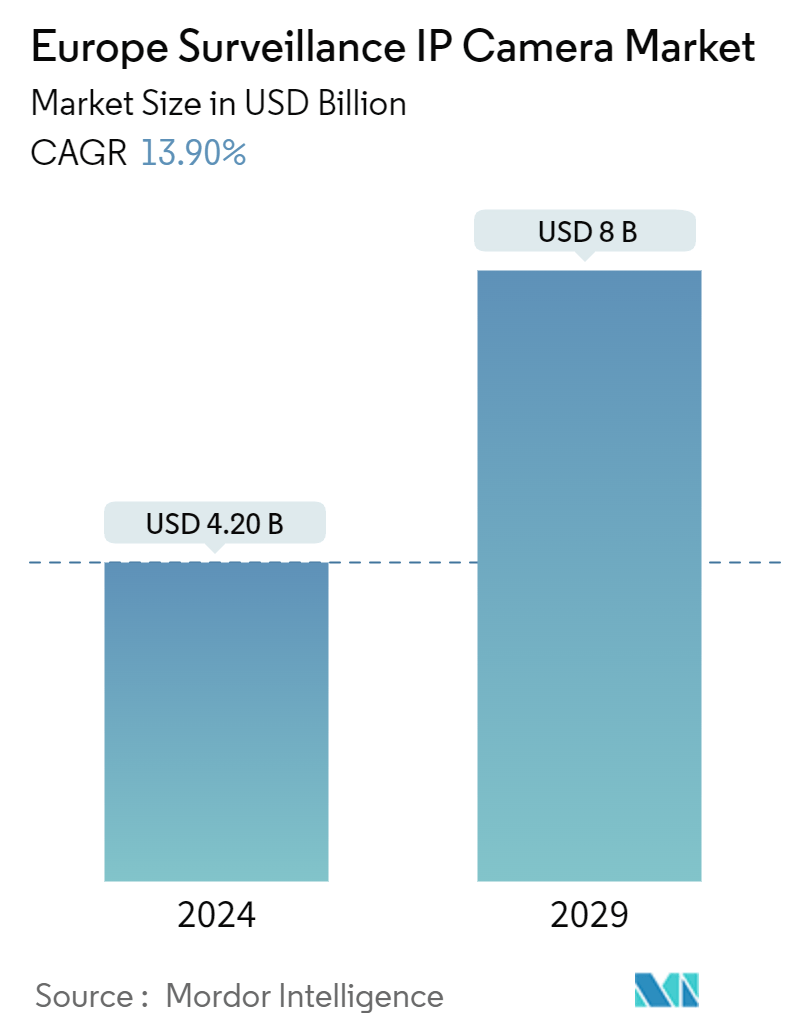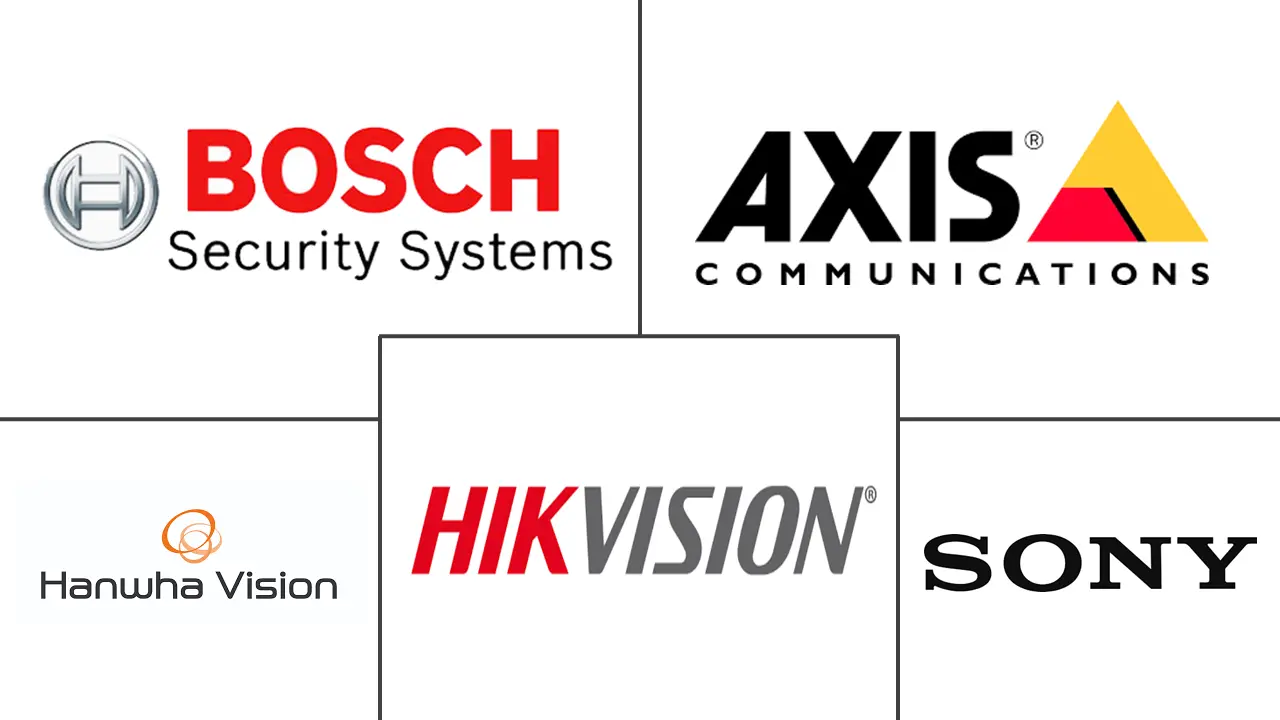Market Size of Europe Surveillance IP Camera Industry

| Study Period | 2019 - 2029 |
| Base Year For Estimation | 2023 |
| Market Size (2024) | USD 4.20 Billion |
| Market Size (2029) | USD 8 Billion |
| CAGR (2024 - 2029) | 13.90 % |
| Market Concentration | Low |
Major Players
*Disclaimer: Major Players sorted in no particular order |
Europe Surveillance IP Camera Market Analysis
The Europe Surveillance IP Camera Market size is estimated at USD 4.20 billion in 2024, and is expected to reach USD 8 billion by 2029, growing at a CAGR of 13.90% during the forecast period (2024-2029).
- Heightened concerns surrounding terrorism, burglary, and other criminal activities underscore the demand for robust surveillance solutions. According to Numbeo, in 2024, France has a 55.3 crime index rate, considered the highest among all the countries. Both governmental bodies and private enterprises are increasingly turning to IP camera systems to bolster safety in urban settings, safeguard critical infrastructure, and protect high-risk areas. This shift is part of a broader movement towards proactive security measures, with IP cameras at the forefront of threat detection, incident response, and investigative efforts.
- Technological strides in camera sensors, marked by higher resolutions, improved low-light performance, and broader dynamic ranges, have significantly bolstered the quality and functionality of IP cameras. Moreover, advancements in video analytics – encompassing object detection, facial recognition, and behavior analysis – have imbued IP cameras with heightened intelligence, making them more effective for security and monitoring tasks. Pairing IP cameras with cloud computing, mobile applications, and Big Data analytics has further empowered functionalities, enabling remote monitoring, centralized management, and sophisticated data-driven insights.
- Further, retail, logistics, manufacturing, and hospitality businesses are increasingly leveraging IP cameras. These cameras serve multiple purposes, from inventory management and employee monitoring to enhancing customer experiences. IP cameras are poised to introduce even more advanced features, such as face detection and recognition. Retailers, for instance, are set to harness intelligent video analytics (IVA) capabilities, including people counting and heatmaps, to scrutinize footfall patterns and bolster their bottom line. Meanwhile, public spaces and transport centers are turning to IVAs, particularly for features like Missing/Suspicious Object Detection, to bolster security. On the other hand, manufacturing facilities and warehouses increasingly adopt IVAs, such as On-Duty Detection and Safety Helmet Detection, to prioritize employee safety.
- Stringent data protection regulations, exemplified by the EU's GDPR, have heightened concerns regarding the ethical use of surveillance cameras and the safeguarding of personal data. Adhering to these regulations necessitates that both IP camera manufacturers and end-users adopt stringent data security protocols, thereby potentially escalating deployment complexities and costs.
- Although the costs of IP cameras have trended downwards, the initial outlay for a comprehensive surveillance setup, encompassing cameras, networking infrastructure, and storage, can still pose a financial hurdle for many. Additionally, ongoing expenses related to maintenance, software updates, and technical assistance further compound the total cost of ownership, often rendering the investment a tough sell for organizations.
- Macroeconomic factors such as Russia-Ukraine war impacted as the supply chains have directly impacted the availability and distribution of electronic components, notably those crucial for IP camera manufacturing. Consequently, these disruptions have triggered shortages, shipment delays, and price hikes for IP cameras and associated gear. The impact is particularly pronounced in European nations heavily dependent on imports.
Europe Surveillance IP Camera Industry Segmentation
As an internet-based substitute for traditional closed-circuit television (CCTV) systems, IP surveillance allows IP-ready cameras to stream visual data directly to the internet. This enables camera owners to conveniently monitor feeds from their mobile devices, laptops, or any other internet-connected device, enhancing the ease of remote surveillance. Compared to CCTV, IP surveillance boasts simplified installation, higher image quality, cost-efficiency through file compression, and enhanced search capabilities. The market size is estimated by selling IP camera products across several industries. The study also tracks the market's growth trends and macroeconomic factors.
Europe surveillance IP camera market is segmented by end-user industry (government, banking, healthcare, transportation and logistics, industrial, and others [education institutions, retail, and enterprises]) and country (Germany, United Kingdom, France, and the Rest of Europe). The report offers market forecasts and size in value (USD) for all the above segments.
| By End-User Industry | |
| Government | |
| Banking | |
| Healthcare | |
| Transportation and Logistics | |
| Industrial | |
| Others (Education Institutions, Retail, and Enterprises) |
| By Country | |
| Germany | |
| United Kingdom | |
| France |
Europe Surveillance IP Camera Market Size Summary
The European surveillance IP camera market is experiencing significant growth, driven by increasing concerns over security threats such as terrorism and crime. This has led both government and private sectors to invest heavily in IP camera systems to enhance safety in urban areas and protect critical infrastructure. Technological advancements in camera sensors and video analytics have improved the functionality and intelligence of these systems, making them more effective for security and monitoring tasks. The integration of IP cameras with cloud computing and Big Data analytics has further enhanced their capabilities, allowing for remote monitoring and sophisticated data-driven insights. Various industries, including retail, logistics, manufacturing, and hospitality, are leveraging these technologies for purposes ranging from inventory management to enhancing customer experiences.
The market is characterized by a competitive landscape with numerous global and local players investing in research and development to drive innovation. Strategic partnerships, mergers, and acquisitions are common as companies strive to maintain their competitive edge. The UK, in particular, has seen a substantial increase in the deployment of IP camera systems, supported by government investments in infrastructure and a robust tech landscape. However, challenges such as stringent data protection regulations and macroeconomic factors like supply chain disruptions due to geopolitical tensions have impacted the market. Despite these challenges, the market is poised for continued growth, with advancements in technology and increasing demand for security solutions driving its expansion.
Europe Surveillance IP Camera Market Size - Table of Contents
-
1. MARKET INSIGHTS
-
1.1 Market Overview
-
1.2 Industry Attractiveness - Porter's Five Forces Analysis
-
1.2.1 Threat of New Entrants
-
1.2.2 Bargaining Power of Buyers
-
1.2.3 Bargaining Power of Suppliers
-
1.2.4 Threat of Substitute Products
-
1.2.5 Intensity of Competitive Rivalry
-
-
1.3 Industry Value Chain Analysis
-
1.4 An Assessment of Macroeconomic Trends on the Market
-
-
2. MARKET SEGMENTATION
-
2.1 By End-User Industry
-
2.1.1 Government
-
2.1.2 Banking
-
2.1.3 Healthcare
-
2.1.4 Transportation and Logistics
-
2.1.5 Industrial
-
2.1.6 Others (Education Institutions, Retail, and Enterprises)
-
-
2.2 By Country
-
2.2.1 Germany
-
2.2.2 United Kingdom
-
2.2.3 France
-
-
Europe Surveillance IP Camera Market Size FAQs
How big is the Europe Surveillance IP Camera Market?
The Europe Surveillance IP Camera Market size is expected to reach USD 4.20 billion in 2024 and grow at a CAGR of 13.90% to reach USD 8 billion by 2029.
What is the current Europe Surveillance IP Camera Market size?
In 2024, the Europe Surveillance IP Camera Market size is expected to reach USD 4.20 billion.

